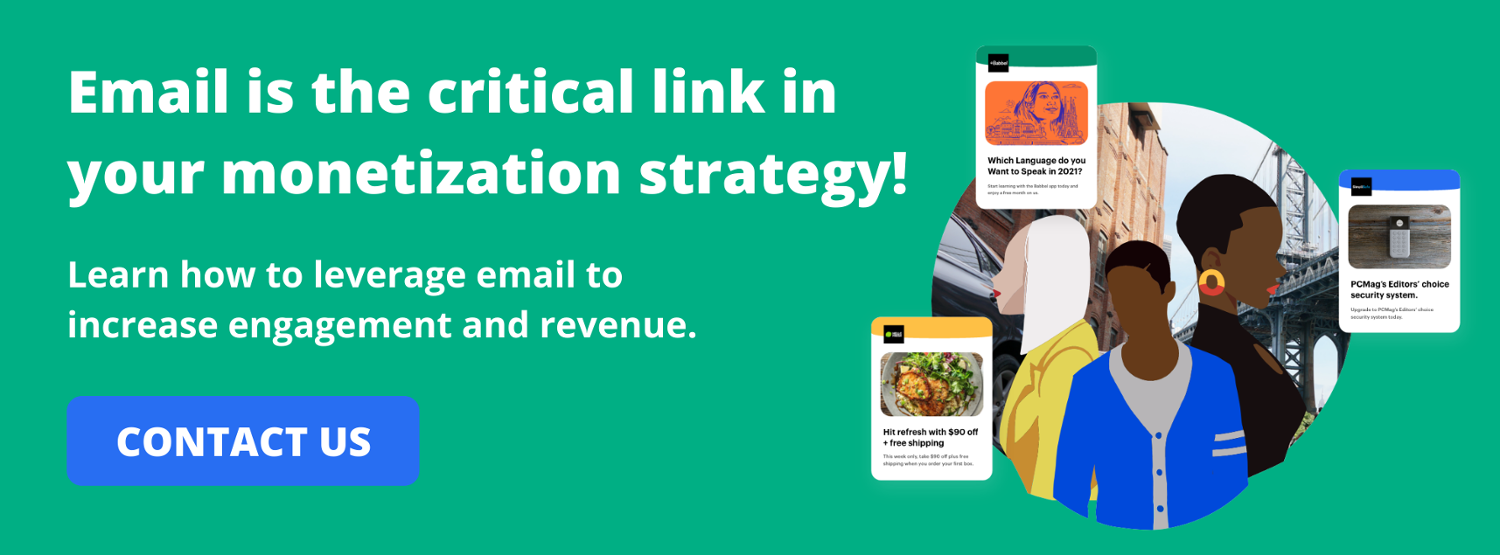Over half of the world population — roughly 4 billion people — use email. And they don’t use it lightly. According to Adobe’s report, the typical user devotes three hours every day to monitoring their professional emails and two hours daily to browsing their personal emails, resulting in a combined five-hour portion of their daily focus being allocated to email.
People evidently love their inboxes. Just look at the data: almost half of consumers say email is their preferred channel for brand communication. So, brands and publishers should love them, too. Having a robust and creative email marketing strategy unlocks success and connection to your most important customers.
In fact, email beats many other digital marketing platforms — including social and search — as the best place to put ads.
Here are 5 reasons why email marketing deserves your attention:
1. Email supports a range of ad types
Have a collection of native ads, text ads, or display ads ready to go? Place them in email newsletters, which can accommodate a range of ad formats. Or if you’re creating ads from scratch, know that you don’t have to manipulate them to fit a specific email format. Instead, you can focus on including the ad elements that best speak to your brand and audiences.
Banner ads, for example, can be incorporated into the top, middle, or sidebar of an email, just as they might be on a web page or article. Native ads or sponsored content, which match the surrounding format, fit seamlessly into the user experience of an email. And text ads in emails do the same, presenting a more straightforward message to readers who can then click and drive engagement.
2. Ads in emails don’t have to be IAB-sized
The Interactive Advertising Bureau (IAB) sets standard ad units, which are recommended for use across websites, apps, and social media platforms. Email, however, isn’t subject to the same restrictions. Just as email supports a variety of ad formats, it also hosts a range of ad sizes — giving marketers greater flexibility in creating engaging and effective assets.
At Jeeng, for example, we support standard display ad sizes like 970×250, 728×90, 300×250, as well as custom ad units according to each brand’s needs and target newsletters.
3. Trust is inherent in email
In an age of growing mistrust and misinformation online, brands must earn trust from their audiences. That’s where effective email marketing strategy comes in.
On email, users have already opted-in to their experience. They’ve agreed to receive communications from a publisher and are ready to access more information. By placing ads in emails, businesses reach email clients with relevant, personalized content that matches their exhibited interests — and on a channel where they’re proven to be receptive and engaged. Email marketing is a fundamental method for extending customer loyalty and staying connected to old and new customers.
4. Collect first-party data for valuable insights
First-party data is the key to survival for publishers and brands going forward. With the third-party cookie on its way out the door, media channels must be able to collect, control, and categorize their own user data. Otherwise, Facebook and Google will beat them to it.
The good news is that email marketing builds a treasure trove of first-party data. By having email addresses at their fingertips, advertisers can more effectively and accurately identify users, create segmented audiences, and target consumers with personalized ad experiences — directly in their inboxes, where they’re already spending a lot of time and attention. Harness this first-pay data to build captivating future campaigns that are not only on-brand, but also targeted to the wishes and behaviors of your email subscribers.
5. Increase engagement and revenue
When utilizing relevant and targeted ads in your email marketing campaigns, your audience gets what they are looking for: on-brand messages that encourage them to engage with your content. This is an important step for monetization, because you’ve carefully crafted messages that are interesting and applicable to your readers. These ads have a better chance of getting clicked and increasing revenue for your bottom line.
When prioritizing user engagement, keep in mind your subject line since that’s the first thing your readers notice in their inbox. This is your one shot at convincing them to open email, which gets the ball rolling for increased revenue.
In addition, having a specific call-to-action in your email marketing campaigns also increases engagement and gives your emails direction. Effective email marketing campaigns should have a clear point, whether it’s to update readers on new services, offer deals, or stay current with holidays or special events. That’s where your call-to-action gets refined and encourages your email subscribers to follow your brand from the inbox into the checkout page.
When you’ve placed ads that are relevant and on-topic, you can monetize your email marketing campaigns and see those click-through rates and engagement numbers go up and up.
—
Ready to start prioritizing your email marketing campaigns to drive revenue and build customer relationships by placing ads in emails? Get in touch with Jeeng today.




